ITC548 System Analysis: Requirements Report on Cloud Solutions
VerifiedAdded on 2024/05/21
|17
|2874
|282
Report
AI Summary
This report provides a system analysis of cloud-based solutions for the "My Health Record" project, focusing on enhancing patient data management. It reviews different cloud architectures (SaaS, IaaS, PaaS), highlighting the advantages and disadvantages of each, and recommends SaaS for its cost-effectiveness and scalability. The report addresses data security concerns, vendor selection (cloud service providers, medical suppliers, healthcare service providers), and the System Development Life Cycle (SDLC) approach, comparing adaptive and predictive SDLC models. It emphasizes the importance of security measures like authentication, data encryption, and authorization to protect sensitive patient information from external threats. The document also discusses the benefits and drawbacks of cloud-based solutions, such as cost savings, reliability, downtime, and vendor lock-in.
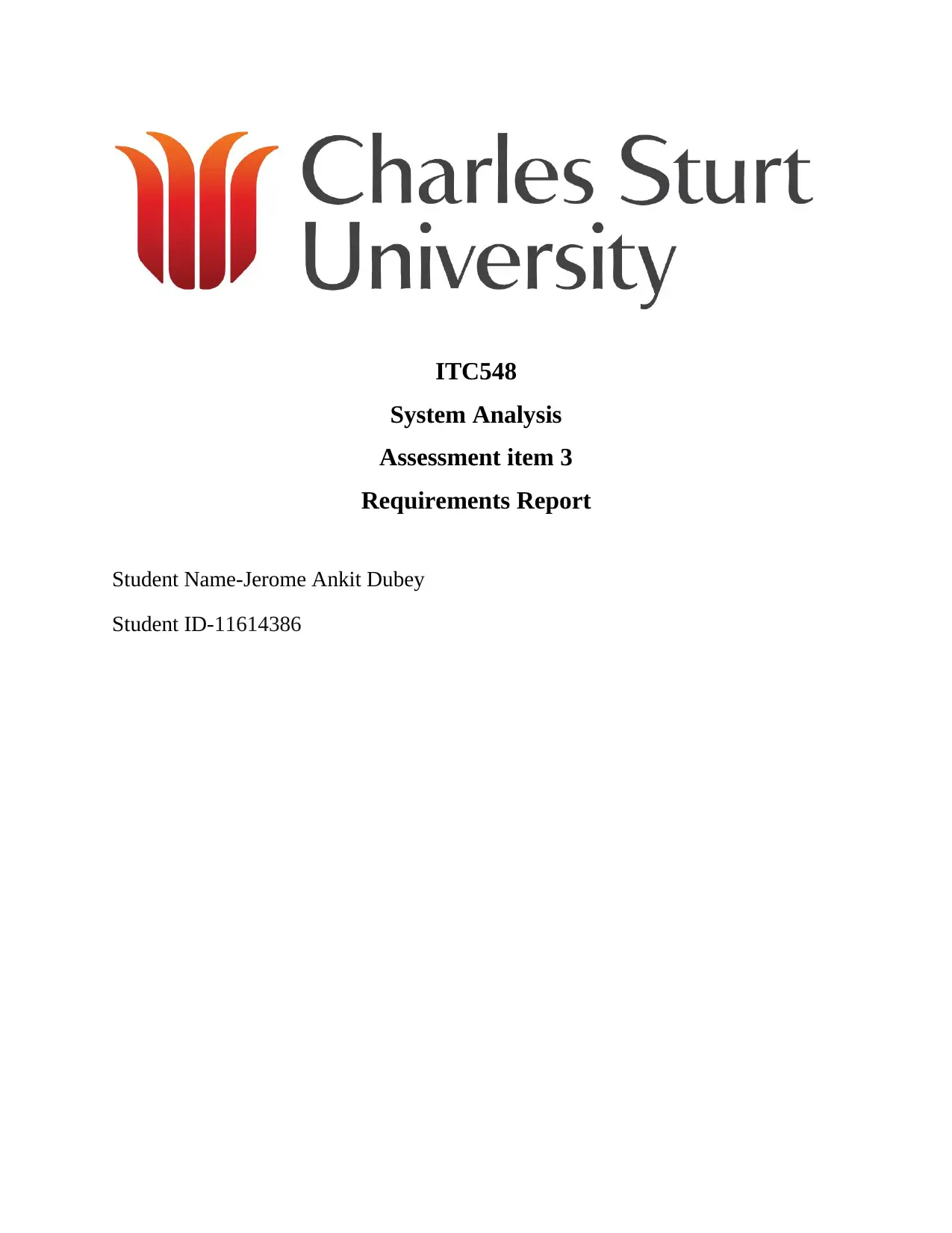
ITC548
System Analysis
Assessment item 3
Requirements Report
Student Name-Jerome Ankit Dubey
Student ID-11614386
System Analysis
Assessment item 3
Requirements Report
Student Name-Jerome Ankit Dubey
Student ID-11614386
Paraphrase This Document
Need a fresh take? Get an instant paraphrase of this document with our AI Paraphraser
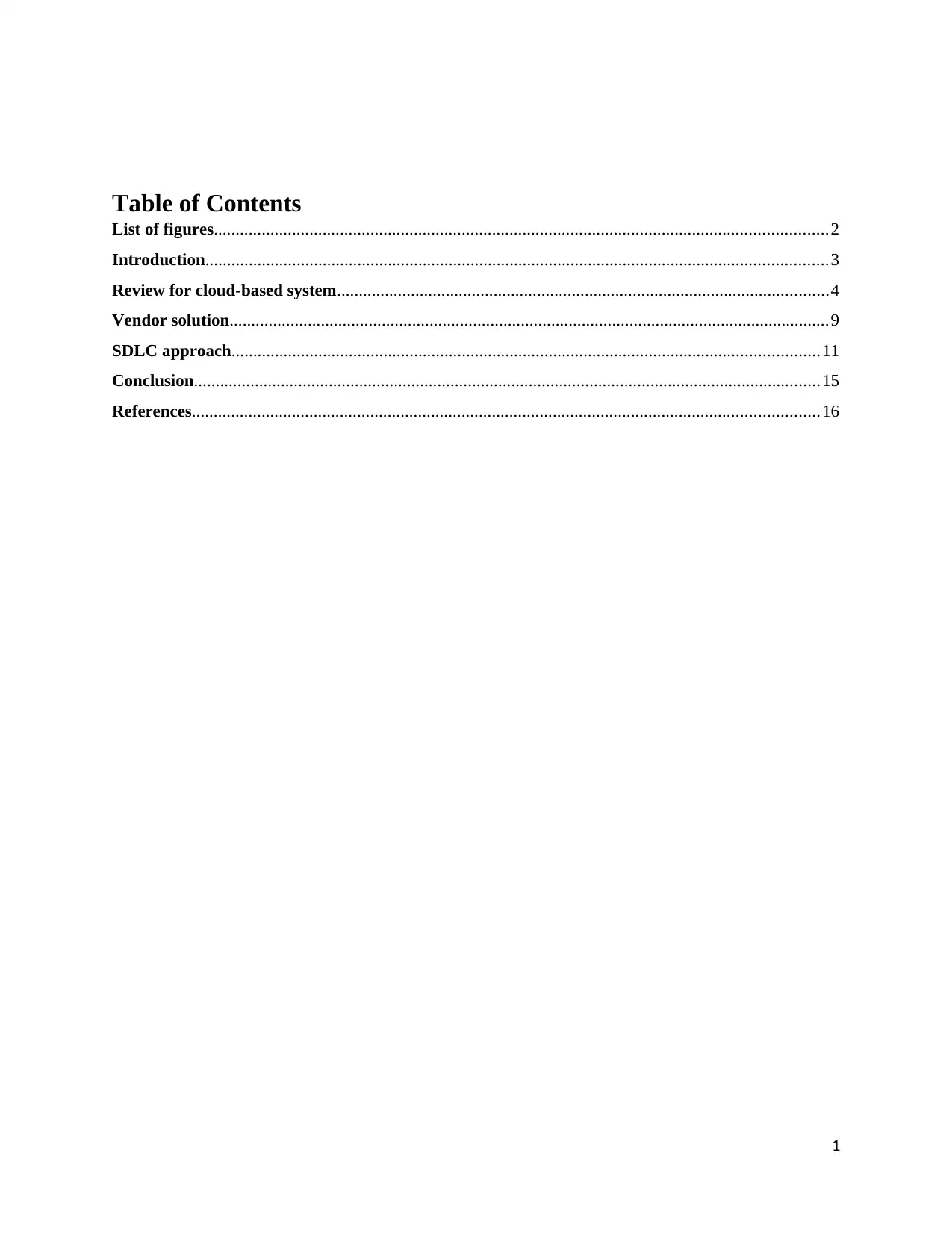
Table of Contents
List of figures.............................................................................................................................................2
Introduction...............................................................................................................................................3
Review for cloud-based system.................................................................................................................4
Vendor solution..........................................................................................................................................9
SDLC approach.......................................................................................................................................11
Conclusion................................................................................................................................................15
References................................................................................................................................................16
1
List of figures.............................................................................................................................................2
Introduction...............................................................................................................................................3
Review for cloud-based system.................................................................................................................4
Vendor solution..........................................................................................................................................9
SDLC approach.......................................................................................................................................11
Conclusion................................................................................................................................................15
References................................................................................................................................................16
1
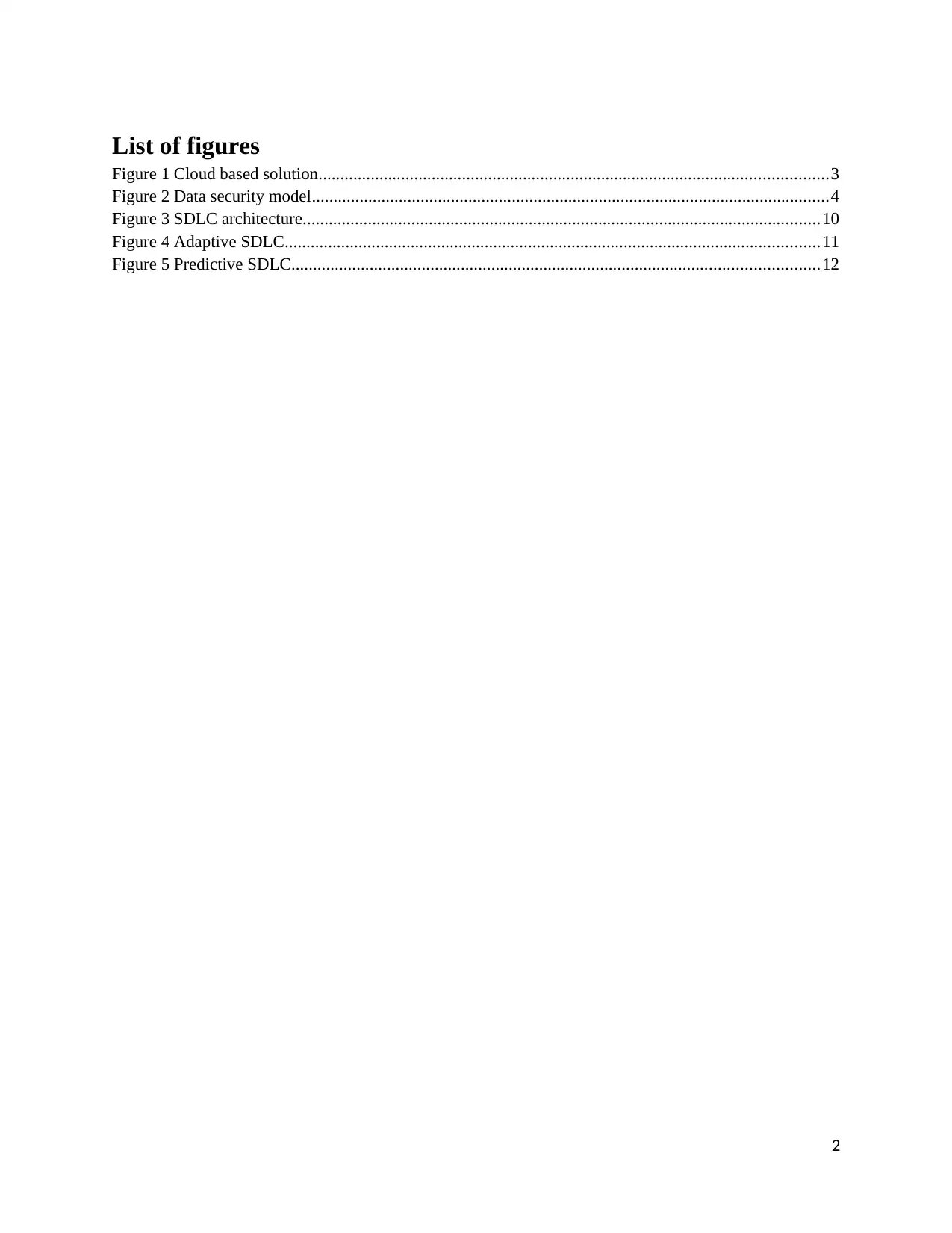
List of figures
Figure 1 Cloud based solution.....................................................................................................................3
Figure 2 Data security model.......................................................................................................................4
Figure 3 SDLC architecture.......................................................................................................................10
Figure 4 Adaptive SDLC...........................................................................................................................11
Figure 5 Predictive SDLC.........................................................................................................................12
2
Figure 1 Cloud based solution.....................................................................................................................3
Figure 2 Data security model.......................................................................................................................4
Figure 3 SDLC architecture.......................................................................................................................10
Figure 4 Adaptive SDLC...........................................................................................................................11
Figure 5 Predictive SDLC.........................................................................................................................12
2
⊘ This is a preview!⊘
Do you want full access?
Subscribe today to unlock all pages.

Trusted by 1+ million students worldwide
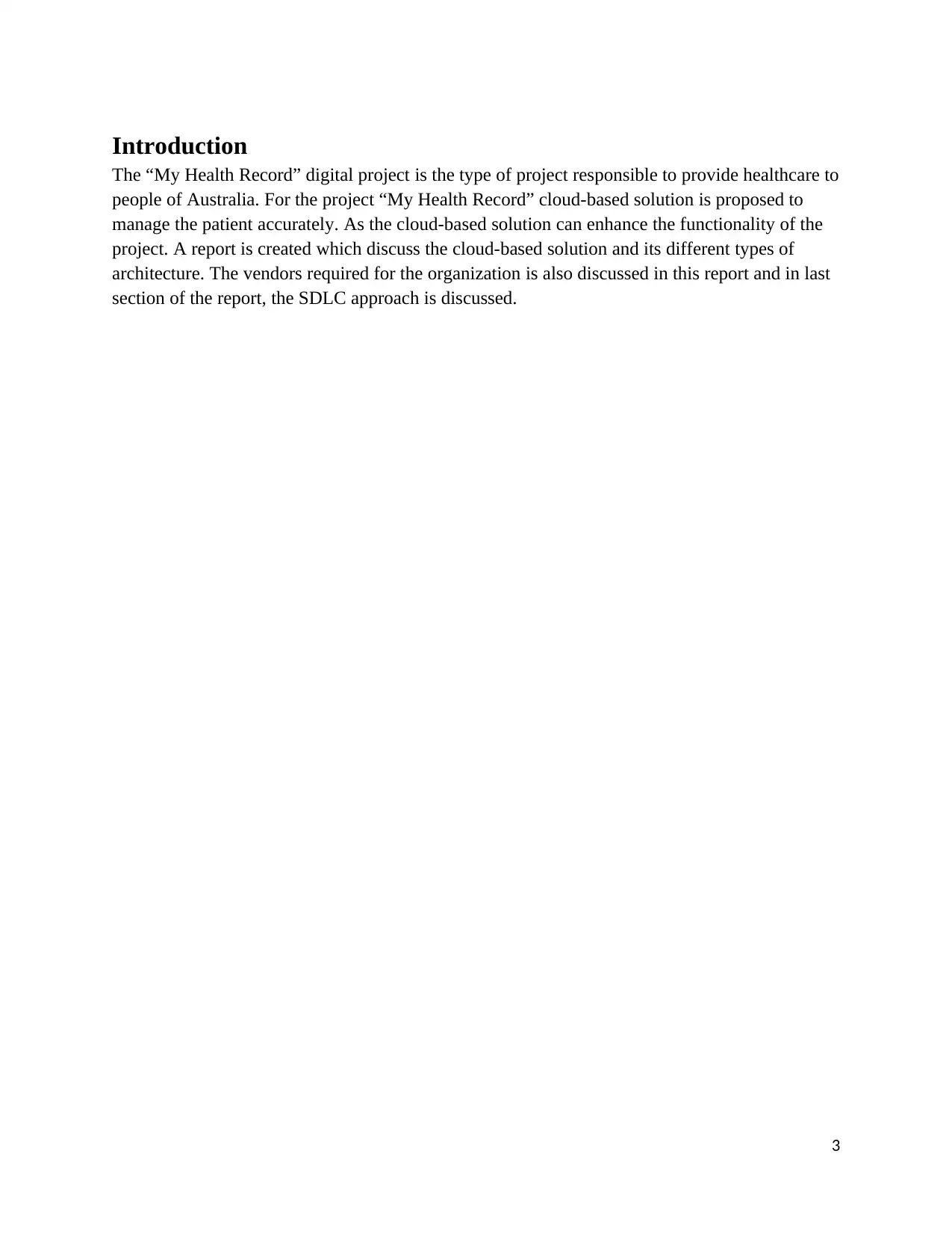
Introduction
The “My Health Record” digital project is the type of project responsible to provide healthcare to
people of Australia. For the project “My Health Record” cloud-based solution is proposed to
manage the patient accurately. As the cloud-based solution can enhance the functionality of the
project. A report is created which discuss the cloud-based solution and its different types of
architecture. The vendors required for the organization is also discussed in this report and in last
section of the report, the SDLC approach is discussed.
3
The “My Health Record” digital project is the type of project responsible to provide healthcare to
people of Australia. For the project “My Health Record” cloud-based solution is proposed to
manage the patient accurately. As the cloud-based solution can enhance the functionality of the
project. A report is created which discuss the cloud-based solution and its different types of
architecture. The vendors required for the organization is also discussed in this report and in last
section of the report, the SDLC approach is discussed.
3
Paraphrase This Document
Need a fresh take? Get an instant paraphrase of this document with our AI Paraphraser
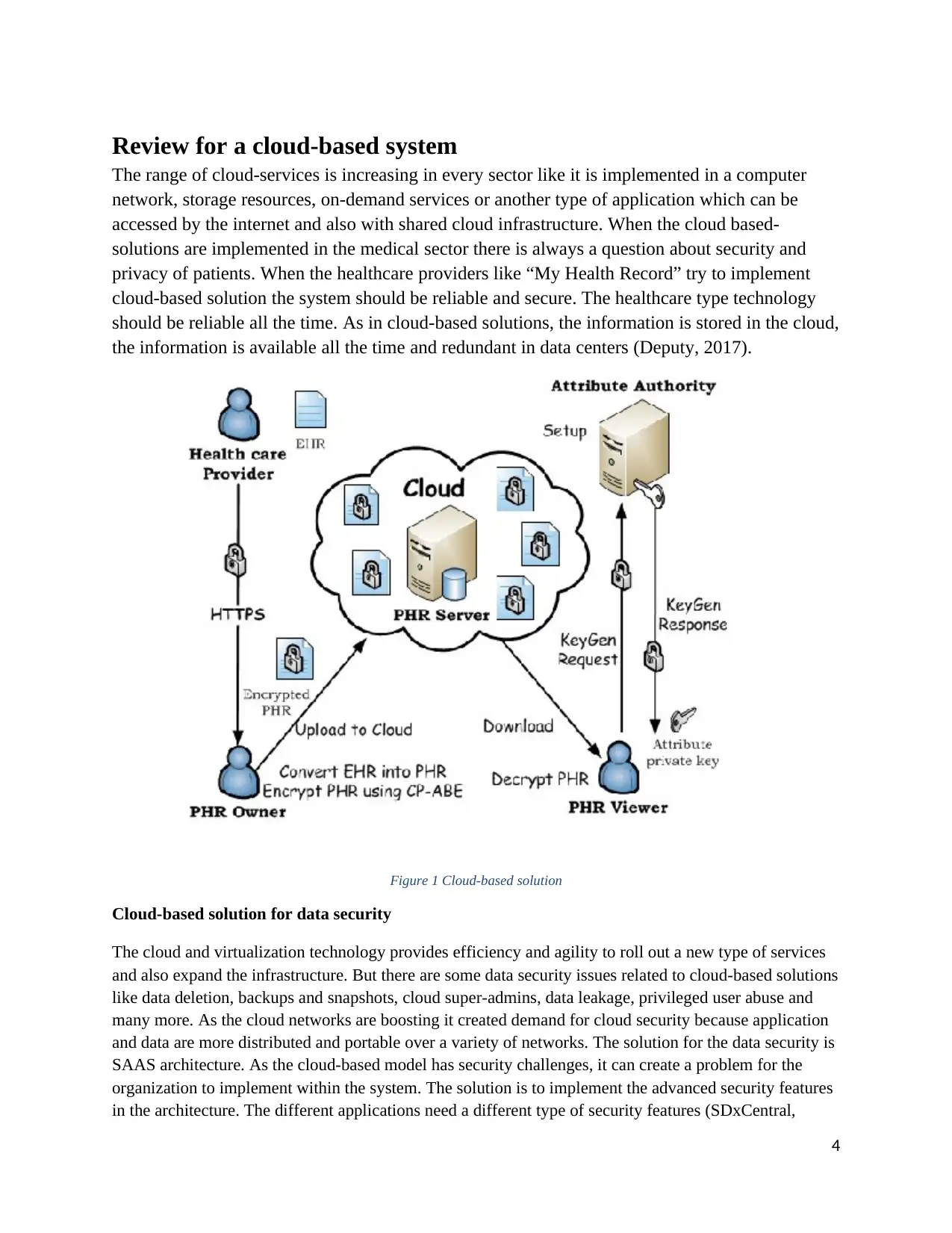
Review for a cloud-based system
The range of cloud-services is increasing in every sector like it is implemented in a computer
network, storage resources, on-demand services or another type of application which can be
accessed by the internet and also with shared cloud infrastructure. When the cloud based-
solutions are implemented in the medical sector there is always a question about security and
privacy of patients. When the healthcare providers like “My Health Record” try to implement
cloud-based solution the system should be reliable and secure. The healthcare type technology
should be reliable all the time. As in cloud-based solutions, the information is stored in the cloud,
the information is available all the time and redundant in data centers (Deputy, 2017).
Figure 1 Cloud-based solution
Cloud-based solution for data security
The cloud and virtualization technology provides efficiency and agility to roll out a new type of services
and also expand the infrastructure. But there are some data security issues related to cloud-based solutions
like data deletion, backups and snapshots, cloud super-admins, data leakage, privileged user abuse and
many more. As the cloud networks are boosting it created demand for cloud security because application
and data are more distributed and portable over a variety of networks. The solution for the data security is
SAAS architecture. As the cloud-based model has security challenges, it can create a problem for the
organization to implement within the system. The solution is to implement the advanced security features
in the architecture. The different applications need a different type of security features (SDxCentral,
4
The range of cloud-services is increasing in every sector like it is implemented in a computer
network, storage resources, on-demand services or another type of application which can be
accessed by the internet and also with shared cloud infrastructure. When the cloud based-
solutions are implemented in the medical sector there is always a question about security and
privacy of patients. When the healthcare providers like “My Health Record” try to implement
cloud-based solution the system should be reliable and secure. The healthcare type technology
should be reliable all the time. As in cloud-based solutions, the information is stored in the cloud,
the information is available all the time and redundant in data centers (Deputy, 2017).
Figure 1 Cloud-based solution
Cloud-based solution for data security
The cloud and virtualization technology provides efficiency and agility to roll out a new type of services
and also expand the infrastructure. But there are some data security issues related to cloud-based solutions
like data deletion, backups and snapshots, cloud super-admins, data leakage, privileged user abuse and
many more. As the cloud networks are boosting it created demand for cloud security because application
and data are more distributed and portable over a variety of networks. The solution for the data security is
SAAS architecture. As the cloud-based model has security challenges, it can create a problem for the
organization to implement within the system. The solution is to implement the advanced security features
in the architecture. The different applications need a different type of security features (SDxCentral,
4
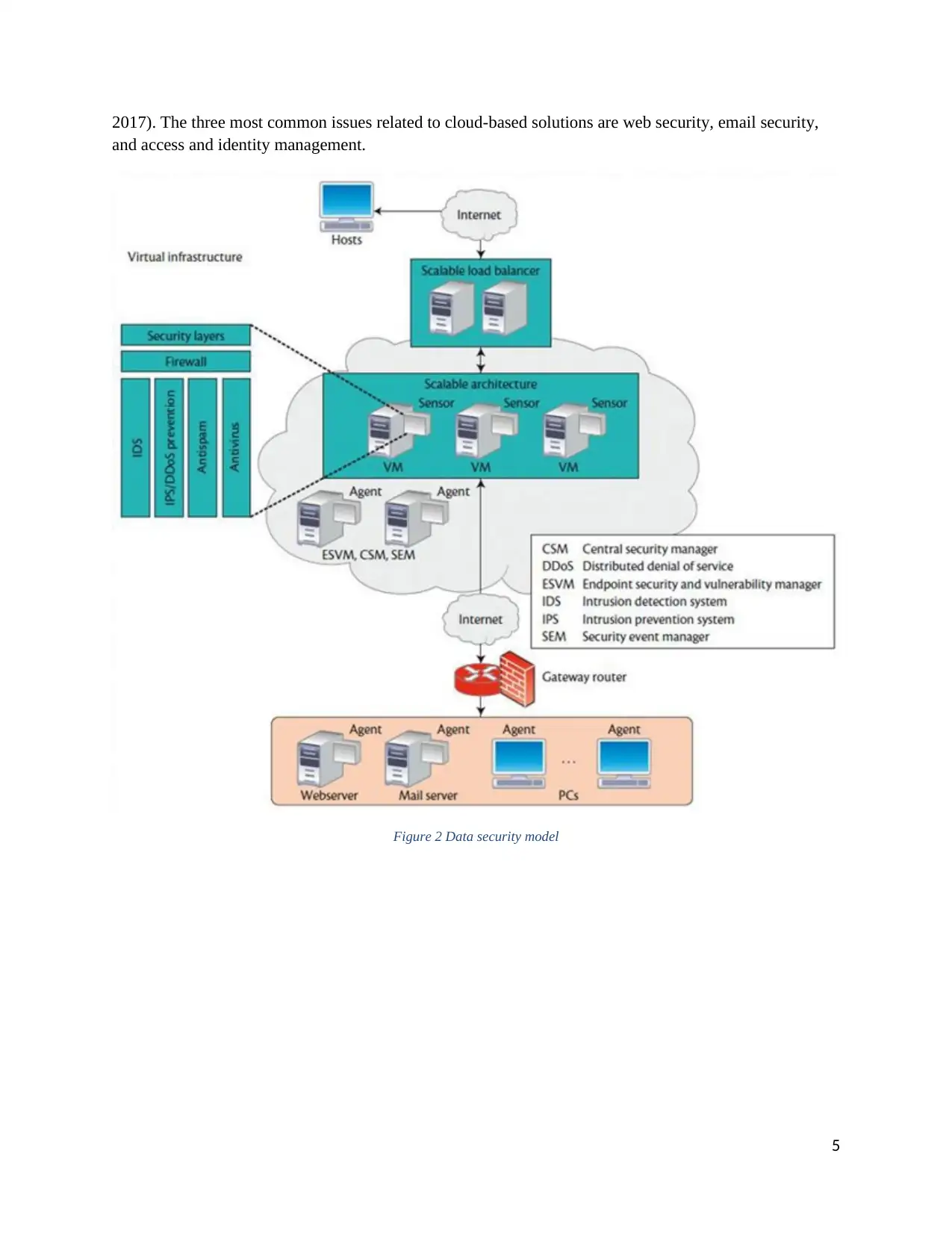
2017). The three most common issues related to cloud-based solutions are web security, email security,
and access and identity management.
Figure 2 Data security model
5
and access and identity management.
Figure 2 Data security model
5
⊘ This is a preview!⊘
Do you want full access?
Subscribe today to unlock all pages.

Trusted by 1+ million students worldwide
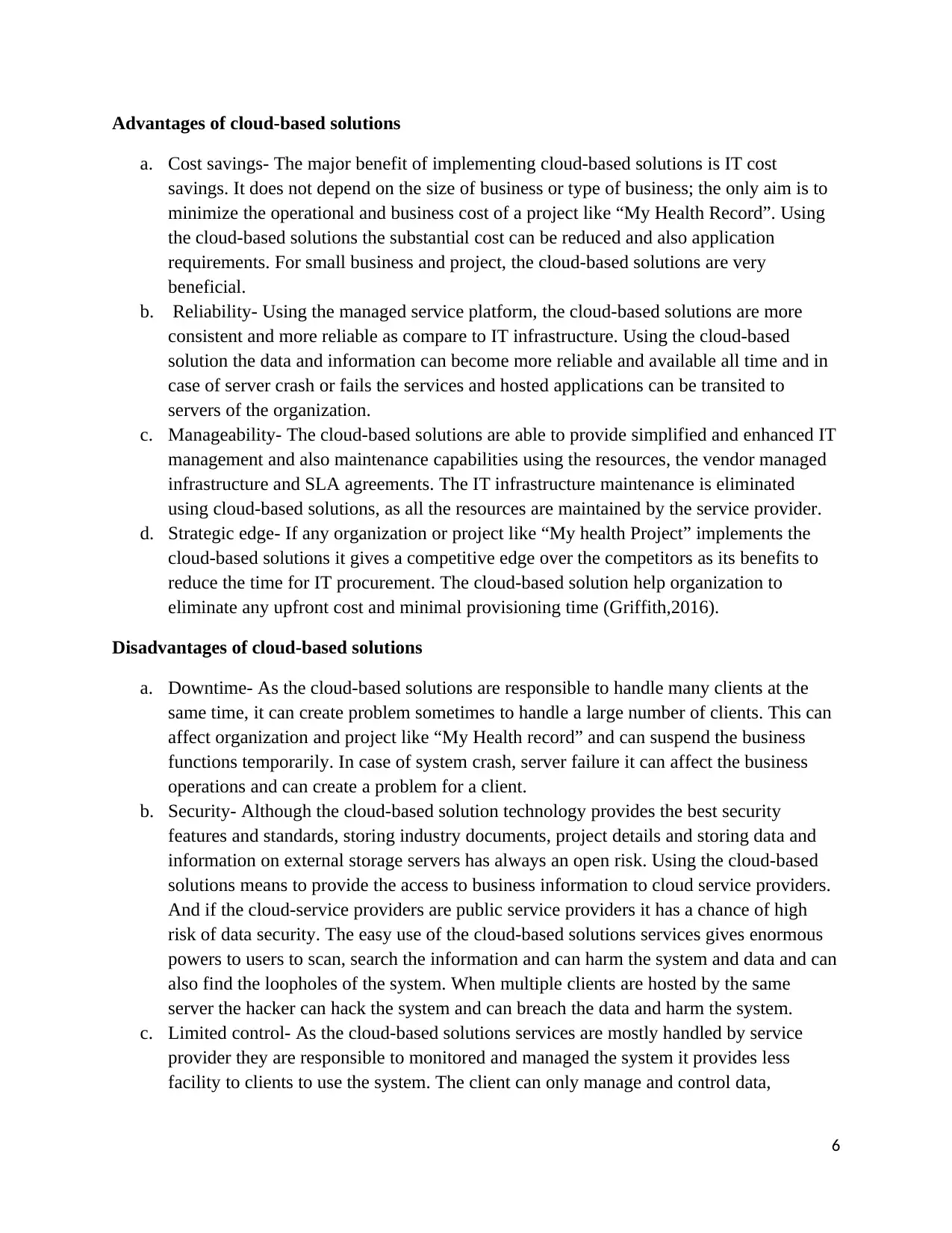
Advantages of cloud-based solutions
a. Cost savings- The major benefit of implementing cloud-based solutions is IT cost
savings. It does not depend on the size of business or type of business; the only aim is to
minimize the operational and business cost of a project like “My Health Record”. Using
the cloud-based solutions the substantial cost can be reduced and also application
requirements. For small business and project, the cloud-based solutions are very
beneficial.
b. Reliability- Using the managed service platform, the cloud-based solutions are more
consistent and more reliable as compare to IT infrastructure. Using the cloud-based
solution the data and information can become more reliable and available all time and in
case of server crash or fails the services and hosted applications can be transited to
servers of the organization.
c. Manageability- The cloud-based solutions are able to provide simplified and enhanced IT
management and also maintenance capabilities using the resources, the vendor managed
infrastructure and SLA agreements. The IT infrastructure maintenance is eliminated
using cloud-based solutions, as all the resources are maintained by the service provider.
d. Strategic edge- If any organization or project like “My health Project” implements the
cloud-based solutions it gives a competitive edge over the competitors as its benefits to
reduce the time for IT procurement. The cloud-based solution help organization to
eliminate any upfront cost and minimal provisioning time (Griffith,2016).
Disadvantages of cloud-based solutions
a. Downtime- As the cloud-based solutions are responsible to handle many clients at the
same time, it can create problem sometimes to handle a large number of clients. This can
affect organization and project like “My Health record” and can suspend the business
functions temporarily. In case of system crash, server failure it can affect the business
operations and can create a problem for a client.
b. Security- Although the cloud-based solution technology provides the best security
features and standards, storing industry documents, project details and storing data and
information on external storage servers has always an open risk. Using the cloud-based
solutions means to provide the access to business information to cloud service providers.
And if the cloud-service providers are public service providers it has a chance of high
risk of data security. The easy use of the cloud-based solutions services gives enormous
powers to users to scan, search the information and can harm the system and data and can
also find the loopholes of the system. When multiple clients are hosted by the same
server the hacker can hack the system and can breach the data and harm the system.
c. Limited control- As the cloud-based solutions services are mostly handled by service
provider they are responsible to monitored and managed the system it provides less
facility to clients to use the system. The client can only manage and control data,
6
a. Cost savings- The major benefit of implementing cloud-based solutions is IT cost
savings. It does not depend on the size of business or type of business; the only aim is to
minimize the operational and business cost of a project like “My Health Record”. Using
the cloud-based solutions the substantial cost can be reduced and also application
requirements. For small business and project, the cloud-based solutions are very
beneficial.
b. Reliability- Using the managed service platform, the cloud-based solutions are more
consistent and more reliable as compare to IT infrastructure. Using the cloud-based
solution the data and information can become more reliable and available all time and in
case of server crash or fails the services and hosted applications can be transited to
servers of the organization.
c. Manageability- The cloud-based solutions are able to provide simplified and enhanced IT
management and also maintenance capabilities using the resources, the vendor managed
infrastructure and SLA agreements. The IT infrastructure maintenance is eliminated
using cloud-based solutions, as all the resources are maintained by the service provider.
d. Strategic edge- If any organization or project like “My health Project” implements the
cloud-based solutions it gives a competitive edge over the competitors as its benefits to
reduce the time for IT procurement. The cloud-based solution help organization to
eliminate any upfront cost and minimal provisioning time (Griffith,2016).
Disadvantages of cloud-based solutions
a. Downtime- As the cloud-based solutions are responsible to handle many clients at the
same time, it can create problem sometimes to handle a large number of clients. This can
affect organization and project like “My Health record” and can suspend the business
functions temporarily. In case of system crash, server failure it can affect the business
operations and can create a problem for a client.
b. Security- Although the cloud-based solution technology provides the best security
features and standards, storing industry documents, project details and storing data and
information on external storage servers has always an open risk. Using the cloud-based
solutions means to provide the access to business information to cloud service providers.
And if the cloud-service providers are public service providers it has a chance of high
risk of data security. The easy use of the cloud-based solutions services gives enormous
powers to users to scan, search the information and can harm the system and data and can
also find the loopholes of the system. When multiple clients are hosted by the same
server the hacker can hack the system and can breach the data and harm the system.
c. Limited control- As the cloud-based solutions services are mostly handled by service
provider they are responsible to monitored and managed the system it provides less
facility to clients to use the system. The client can only manage and control data,
6
Paraphrase This Document
Need a fresh take? Get an instant paraphrase of this document with our AI Paraphraser
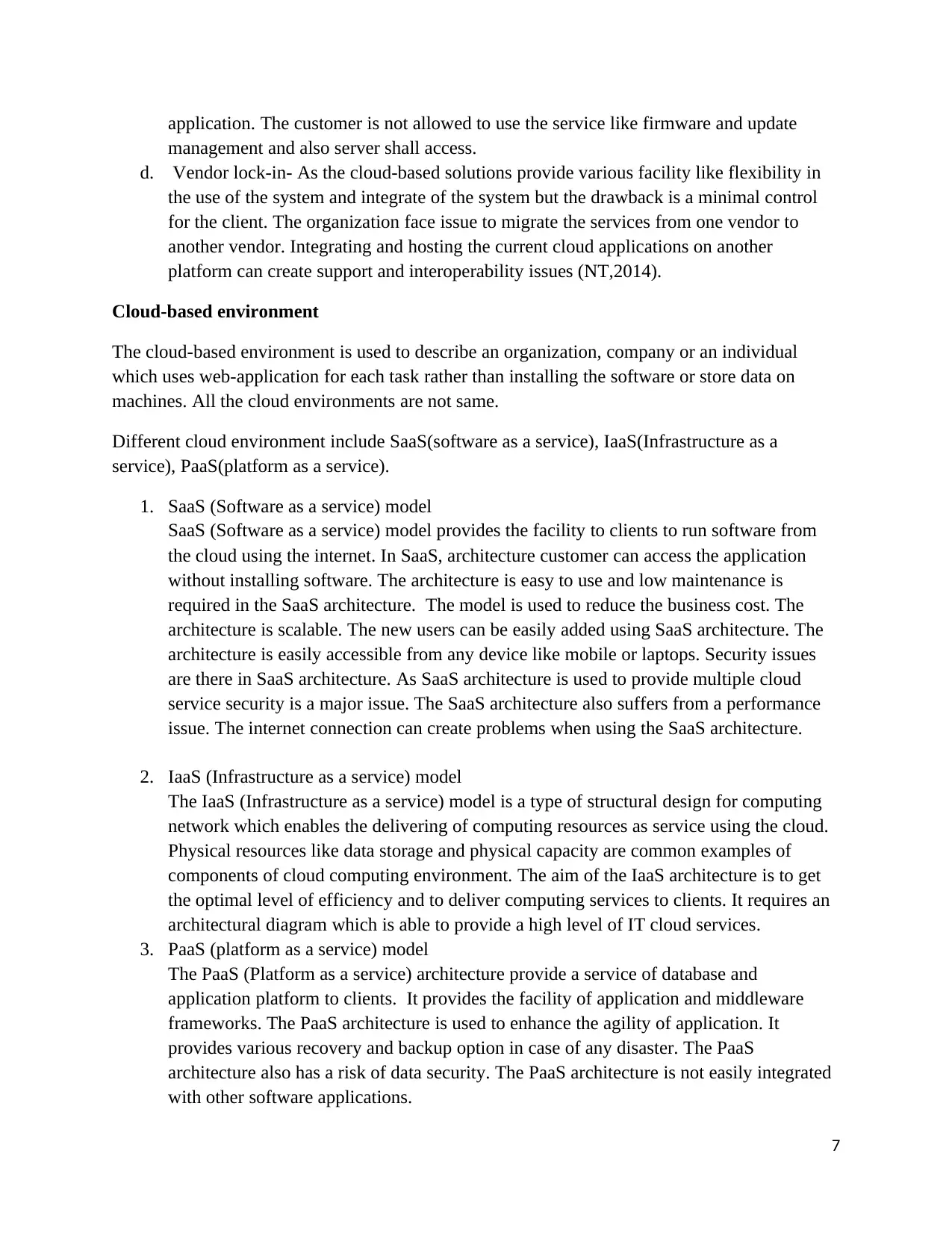
application. The customer is not allowed to use the service like firmware and update
management and also server shall access.
d. Vendor lock-in- As the cloud-based solutions provide various facility like flexibility in
the use of the system and integrate of the system but the drawback is a minimal control
for the client. The organization face issue to migrate the services from one vendor to
another vendor. Integrating and hosting the current cloud applications on another
platform can create support and interoperability issues (NT,2014).
Cloud-based environment
The cloud-based environment is used to describe an organization, company or an individual
which uses web-application for each task rather than installing the software or store data on
machines. All the cloud environments are not same.
Different cloud environment include SaaS(software as a service), IaaS(Infrastructure as a
service), PaaS(platform as a service).
1. SaaS (Software as a service) model
SaaS (Software as a service) model provides the facility to clients to run software from
the cloud using the internet. In SaaS, architecture customer can access the application
without installing software. The architecture is easy to use and low maintenance is
required in the SaaS architecture. The model is used to reduce the business cost. The
architecture is scalable. The new users can be easily added using SaaS architecture. The
architecture is easily accessible from any device like mobile or laptops. Security issues
are there in SaaS architecture. As SaaS architecture is used to provide multiple cloud
service security is a major issue. The SaaS architecture also suffers from a performance
issue. The internet connection can create problems when using the SaaS architecture.
2. IaaS (Infrastructure as a service) model
The IaaS (Infrastructure as a service) model is a type of structural design for computing
network which enables the delivering of computing resources as service using the cloud.
Physical resources like data storage and physical capacity are common examples of
components of cloud computing environment. The aim of the IaaS architecture is to get
the optimal level of efficiency and to deliver computing services to clients. It requires an
architectural diagram which is able to provide a high level of IT cloud services.
3. PaaS (platform as a service) model
The PaaS (Platform as a service) architecture provide a service of database and
application platform to clients. It provides the facility of application and middleware
frameworks. The PaaS architecture is used to enhance the agility of application. It
provides various recovery and backup option in case of any disaster. The PaaS
architecture also has a risk of data security. The PaaS architecture is not easily integrated
with other software applications.
7
management and also server shall access.
d. Vendor lock-in- As the cloud-based solutions provide various facility like flexibility in
the use of the system and integrate of the system but the drawback is a minimal control
for the client. The organization face issue to migrate the services from one vendor to
another vendor. Integrating and hosting the current cloud applications on another
platform can create support and interoperability issues (NT,2014).
Cloud-based environment
The cloud-based environment is used to describe an organization, company or an individual
which uses web-application for each task rather than installing the software or store data on
machines. All the cloud environments are not same.
Different cloud environment include SaaS(software as a service), IaaS(Infrastructure as a
service), PaaS(platform as a service).
1. SaaS (Software as a service) model
SaaS (Software as a service) model provides the facility to clients to run software from
the cloud using the internet. In SaaS, architecture customer can access the application
without installing software. The architecture is easy to use and low maintenance is
required in the SaaS architecture. The model is used to reduce the business cost. The
architecture is scalable. The new users can be easily added using SaaS architecture. The
architecture is easily accessible from any device like mobile or laptops. Security issues
are there in SaaS architecture. As SaaS architecture is used to provide multiple cloud
service security is a major issue. The SaaS architecture also suffers from a performance
issue. The internet connection can create problems when using the SaaS architecture.
2. IaaS (Infrastructure as a service) model
The IaaS (Infrastructure as a service) model is a type of structural design for computing
network which enables the delivering of computing resources as service using the cloud.
Physical resources like data storage and physical capacity are common examples of
components of cloud computing environment. The aim of the IaaS architecture is to get
the optimal level of efficiency and to deliver computing services to clients. It requires an
architectural diagram which is able to provide a high level of IT cloud services.
3. PaaS (platform as a service) model
The PaaS (Platform as a service) architecture provide a service of database and
application platform to clients. It provides the facility of application and middleware
frameworks. The PaaS architecture is used to enhance the agility of application. It
provides various recovery and backup option in case of any disaster. The PaaS
architecture also has a risk of data security. The PaaS architecture is not easily integrated
with other software applications.
7
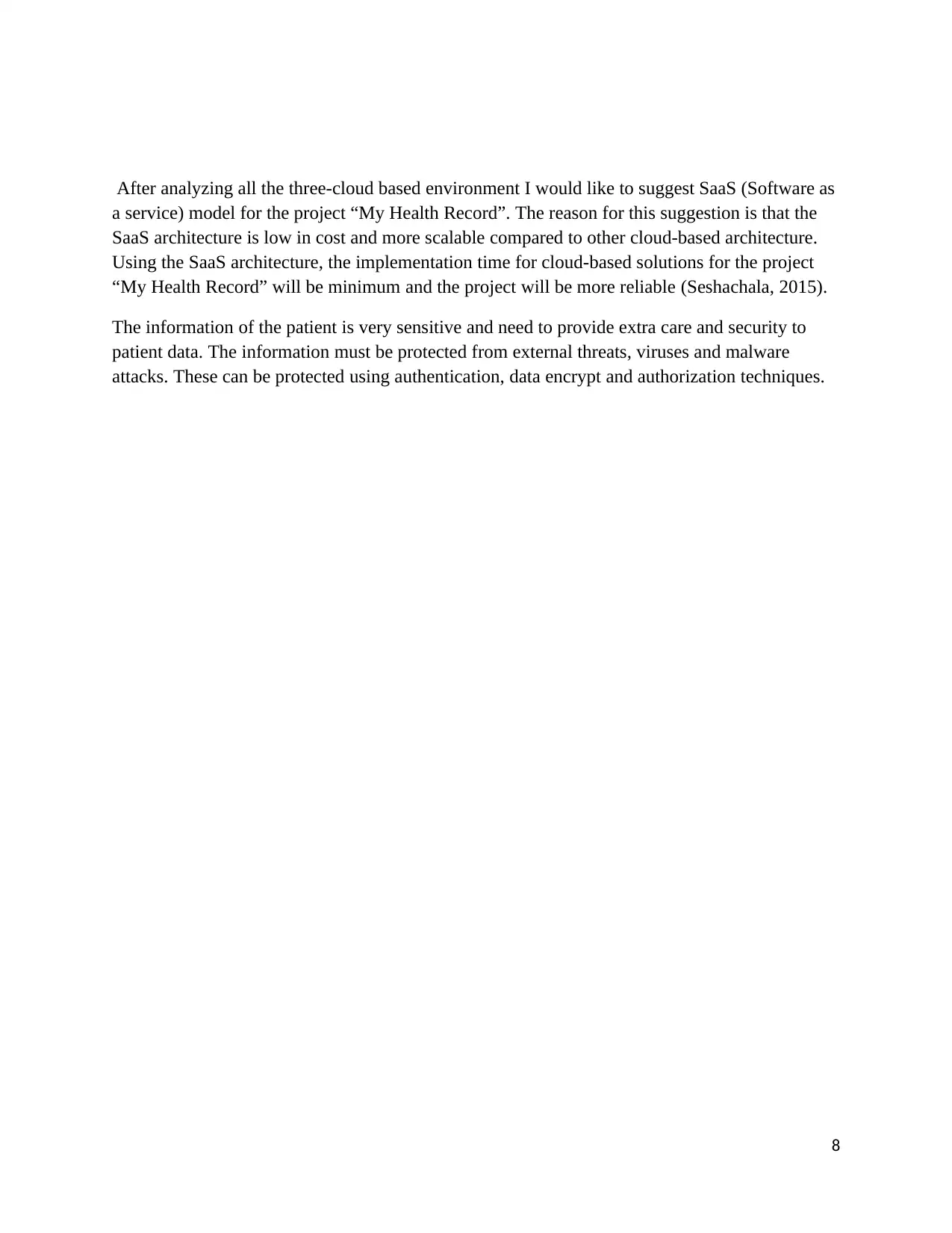
After analyzing all the three-cloud based environment I would like to suggest SaaS (Software as
a service) model for the project “My Health Record”. The reason for this suggestion is that the
SaaS architecture is low in cost and more scalable compared to other cloud-based architecture.
Using the SaaS architecture, the implementation time for cloud-based solutions for the project
“My Health Record” will be minimum and the project will be more reliable (Seshachala, 2015).
The information of the patient is very sensitive and need to provide extra care and security to
patient data. The information must be protected from external threats, viruses and malware
attacks. These can be protected using authentication, data encrypt and authorization techniques.
8
a service) model for the project “My Health Record”. The reason for this suggestion is that the
SaaS architecture is low in cost and more scalable compared to other cloud-based architecture.
Using the SaaS architecture, the implementation time for cloud-based solutions for the project
“My Health Record” will be minimum and the project will be more reliable (Seshachala, 2015).
The information of the patient is very sensitive and need to provide extra care and security to
patient data. The information must be protected from external threats, viruses and malware
attacks. These can be protected using authentication, data encrypt and authorization techniques.
8
⊘ This is a preview!⊘
Do you want full access?
Subscribe today to unlock all pages.

Trusted by 1+ million students worldwide
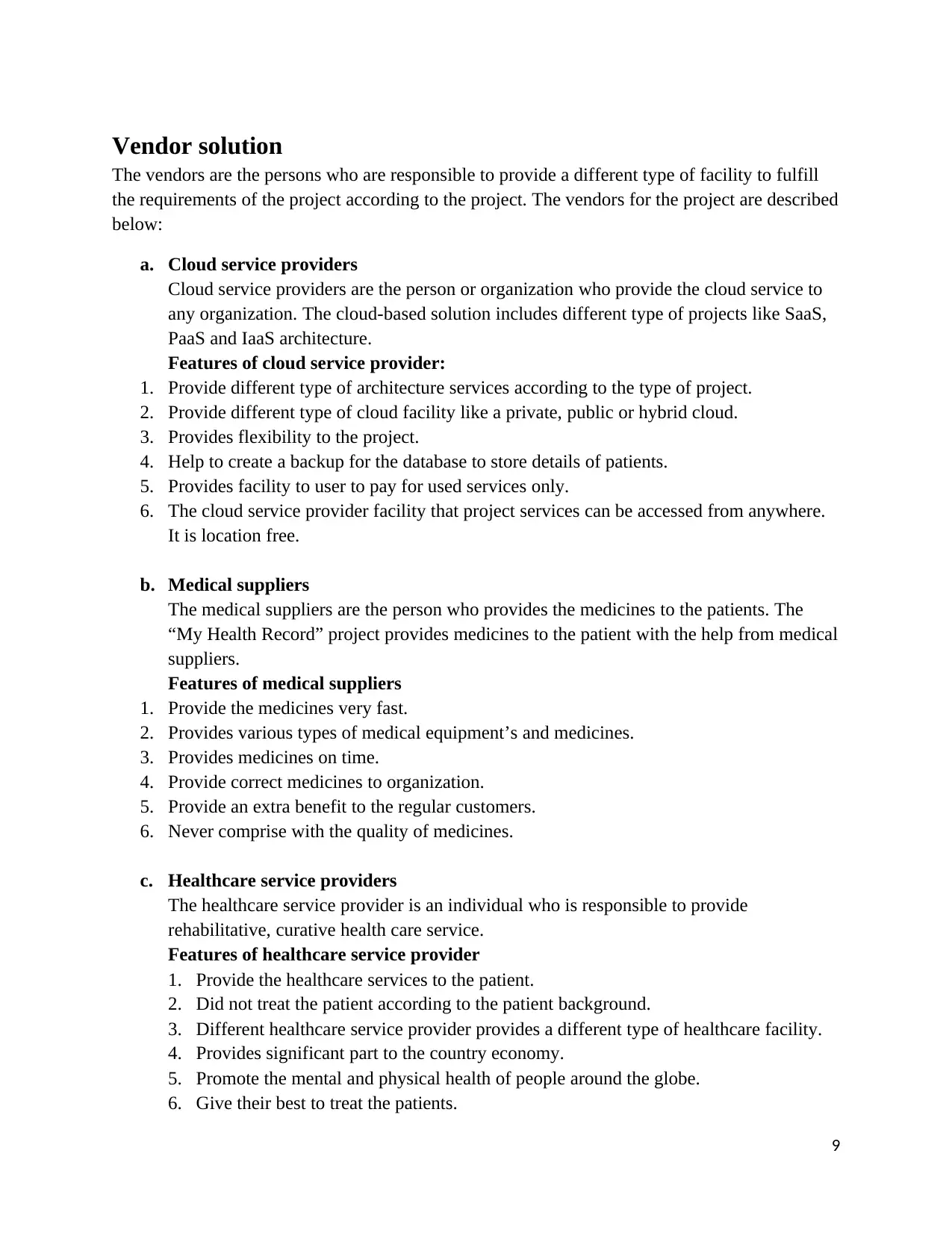
Vendor solution
The vendors are the persons who are responsible to provide a different type of facility to fulfill
the requirements of the project according to the project. The vendors for the project are described
below:
a. Cloud service providers
Cloud service providers are the person or organization who provide the cloud service to
any organization. The cloud-based solution includes different type of projects like SaaS,
PaaS and IaaS architecture.
Features of cloud service provider:
1. Provide different type of architecture services according to the type of project.
2. Provide different type of cloud facility like a private, public or hybrid cloud.
3. Provides flexibility to the project.
4. Help to create a backup for the database to store details of patients.
5. Provides facility to user to pay for used services only.
6. The cloud service provider facility that project services can be accessed from anywhere.
It is location free.
b. Medical suppliers
The medical suppliers are the person who provides the medicines to the patients. The
“My Health Record” project provides medicines to the patient with the help from medical
suppliers.
Features of medical suppliers
1. Provide the medicines very fast.
2. Provides various types of medical equipment’s and medicines.
3. Provides medicines on time.
4. Provide correct medicines to organization.
5. Provide an extra benefit to the regular customers.
6. Never comprise with the quality of medicines.
c. Healthcare service providers
The healthcare service provider is an individual who is responsible to provide
rehabilitative, curative health care service.
Features of healthcare service provider
1. Provide the healthcare services to the patient.
2. Did not treat the patient according to the patient background.
3. Different healthcare service provider provides a different type of healthcare facility.
4. Provides significant part to the country economy.
5. Promote the mental and physical health of people around the globe.
6. Give their best to treat the patients.
9
The vendors are the persons who are responsible to provide a different type of facility to fulfill
the requirements of the project according to the project. The vendors for the project are described
below:
a. Cloud service providers
Cloud service providers are the person or organization who provide the cloud service to
any organization. The cloud-based solution includes different type of projects like SaaS,
PaaS and IaaS architecture.
Features of cloud service provider:
1. Provide different type of architecture services according to the type of project.
2. Provide different type of cloud facility like a private, public or hybrid cloud.
3. Provides flexibility to the project.
4. Help to create a backup for the database to store details of patients.
5. Provides facility to user to pay for used services only.
6. The cloud service provider facility that project services can be accessed from anywhere.
It is location free.
b. Medical suppliers
The medical suppliers are the person who provides the medicines to the patients. The
“My Health Record” project provides medicines to the patient with the help from medical
suppliers.
Features of medical suppliers
1. Provide the medicines very fast.
2. Provides various types of medical equipment’s and medicines.
3. Provides medicines on time.
4. Provide correct medicines to organization.
5. Provide an extra benefit to the regular customers.
6. Never comprise with the quality of medicines.
c. Healthcare service providers
The healthcare service provider is an individual who is responsible to provide
rehabilitative, curative health care service.
Features of healthcare service provider
1. Provide the healthcare services to the patient.
2. Did not treat the patient according to the patient background.
3. Different healthcare service provider provides a different type of healthcare facility.
4. Provides significant part to the country economy.
5. Promote the mental and physical health of people around the globe.
6. Give their best to treat the patients.
9
Paraphrase This Document
Need a fresh take? Get an instant paraphrase of this document with our AI Paraphraser
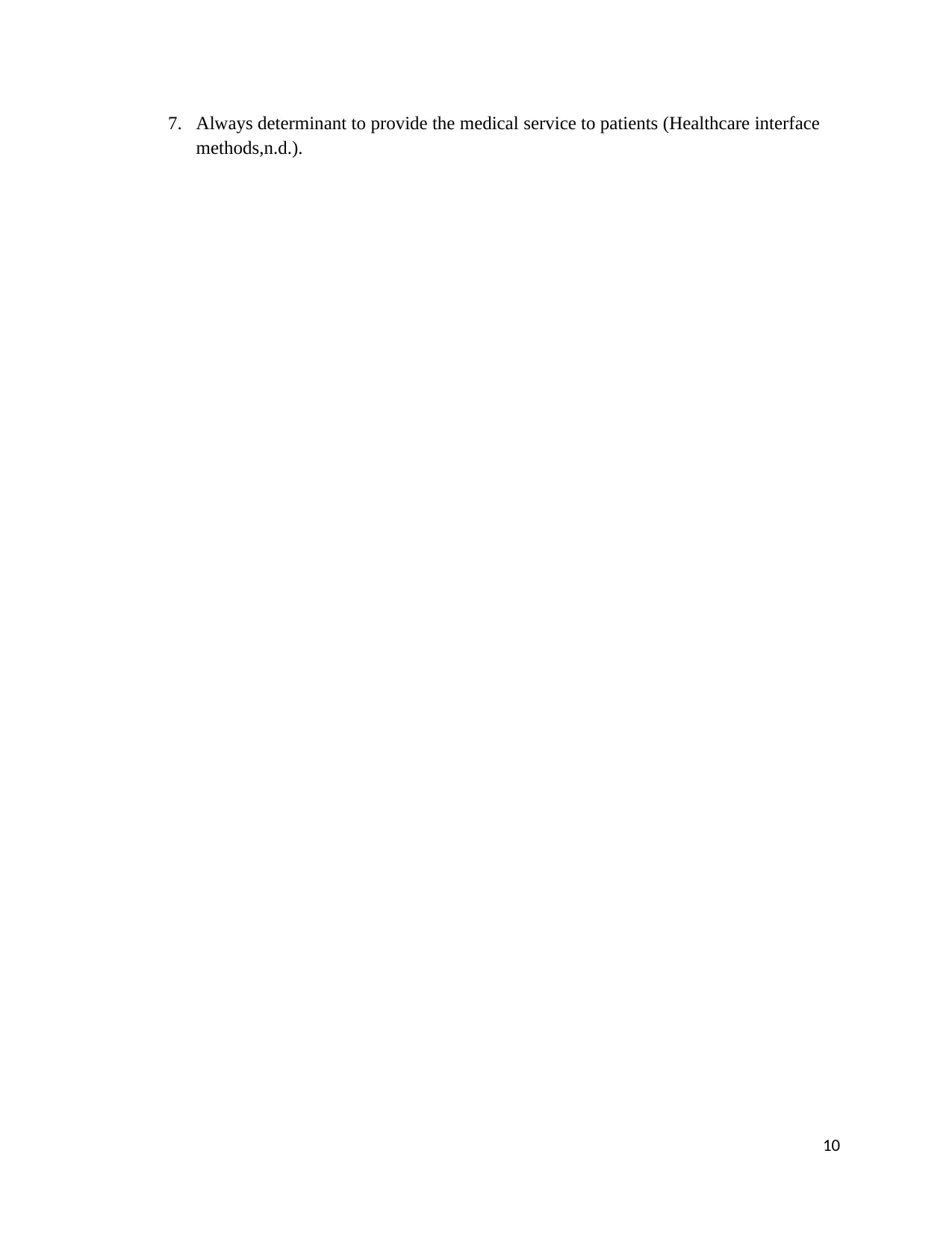
7. Always determinant to provide the medical service to patients (Healthcare interface
methods,n.d.).
10
methods,n.d.).
10
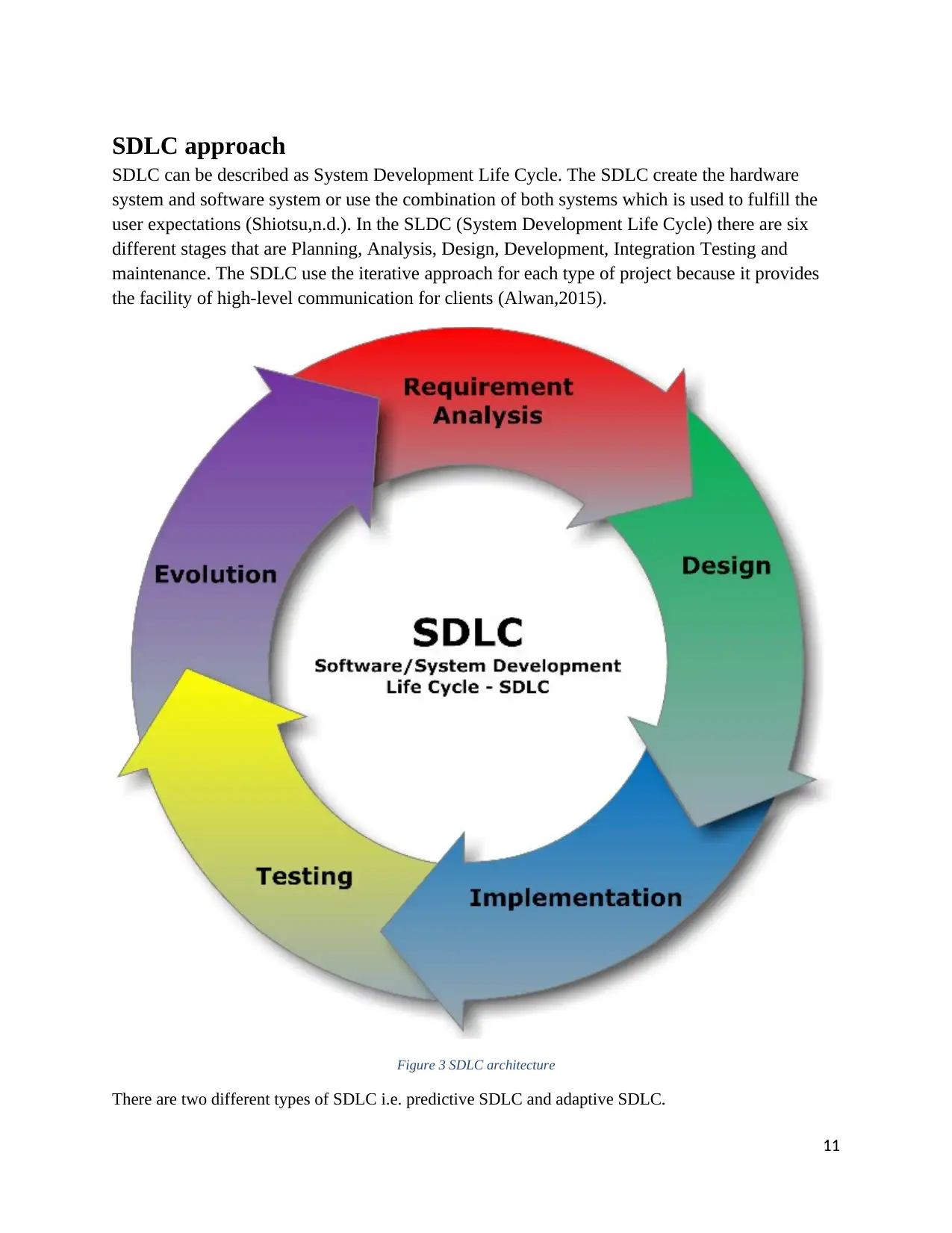
SDLC approach
SDLC can be described as System Development Life Cycle. The SDLC create the hardware
system and software system or use the combination of both systems which is used to fulfill the
user expectations (Shiotsu,n.d.). In the SLDC (System Development Life Cycle) there are six
different stages that are Planning, Analysis, Design, Development, Integration Testing and
maintenance. The SDLC use the iterative approach for each type of project because it provides
the facility of high-level communication for clients (Alwan,2015).
Figure 3 SDLC architecture
There are two different types of SDLC i.e. predictive SDLC and adaptive SDLC.
11
SDLC can be described as System Development Life Cycle. The SDLC create the hardware
system and software system or use the combination of both systems which is used to fulfill the
user expectations (Shiotsu,n.d.). In the SLDC (System Development Life Cycle) there are six
different stages that are Planning, Analysis, Design, Development, Integration Testing and
maintenance. The SDLC use the iterative approach for each type of project because it provides
the facility of high-level communication for clients (Alwan,2015).
Figure 3 SDLC architecture
There are two different types of SDLC i.e. predictive SDLC and adaptive SDLC.
11
⊘ This is a preview!⊘
Do you want full access?
Subscribe today to unlock all pages.

Trusted by 1+ million students worldwide
1 out of 17
Related Documents
Your All-in-One AI-Powered Toolkit for Academic Success.
+13062052269
info@desklib.com
Available 24*7 on WhatsApp / Email
![[object Object]](/_next/static/media/star-bottom.7253800d.svg)
Unlock your academic potential
Copyright © 2020–2025 A2Z Services. All Rights Reserved. Developed and managed by ZUCOL.





